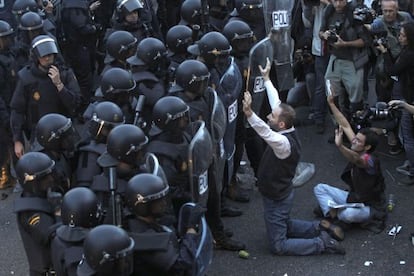A glimpse behind the visors — How Spain’s riot police operate
Violent actions against protestors outside Congress have put the UIP force in the spotlight


As though they had entered a time warp, riot police are back on Spain's streets. But their actions are now under investigation following their controversial actions against protestors on September 25, when the Surround Congress rally took place in Madrid. Riot control officers also entered Atocha station, where they clubbed journalists and people with no connection to the rioters, causing panic in the busy transportation hub.
But who are the members of the Police Intervention Units (UIP)? How are they trained? Who gives them the order to charge? And how are they instructed to use their force?
The UIP was created in 1989 to replace the National Police's reserve corps, a military outfit. Its 12 units are distributed across Spain's most strategic regions from a police viewpoint, with a central unit in Madrid. There are 2,744 men standing by 24 hours a day, ready for the call of duty. One of their missions is to protect the Spanish royals and other high-profile personalities.
Prospective UIP candidates must have at least one year of experience with the National Police corps, and the selection committee looks favorably on diplomas attesting knowledge of martial arts, physical education, shooting, personal defense, civil protection, languages and other academic qualifications.
But the actual selection tests measure physical fitness (swimming, climbing, stamina and speed), technical competence (participating in a simulation) and personal response (assessment of abilities and personality traits). These latter two elements ultimately determine whether a candidate is fit or not for the job. "This is where most of them fail," says one member of the UIP.
Finally, an intensive one-month training course at the police center in Linares, in Jaén province, decides whether the shortlisted candidates may join the UIP. All the successful candidates will return to this center once a year for training. Additionally, every four months officers go through a 24-hour intensive workshop in legal and police-related subject matter. Every day, one hour is spent on personal defense training and another hour on tactical and strategic work.
The police admit that officers infiltrate protests to gather information
Who decides when the UIP may carry out a police charge? "Charges are ordered by the government delegation," says an official spokesman from Madrid police headquarters. "No police official acts on his own without approval from the government delegate."
"Occasionally, the government delegate follows instructions from the police director general or secretary of state for security," says one ex-government delegate who declined to have his name published. "They ask for your approval and you either grant or deny it. I always used to ask that [the charge] be proportional and avoid wounding anyone."
The force's participation in major rallies is always followed from an operations center at Madrid police headquarters, where cameras provide a live feed of the ongoing march. But on September 25 the government delegate in Madrid, Cristina Cifuentes, coordinated the monitoring process from delegation headquarters at the palace of the Marquis of Borghetto.
The order to charge follows a chain of command from the chief inspector in charge of the unit up to the chief of police and the government delegate. The riot police cannot budge without political authorization.
"It depends on each politician's profile whether the chain ends there or continues up to the Interior Minister," says a former high-ranking civil servant. "A politician giving operative orders can become a dangerous thing."
"The UIP officers do what they're told," says José María Benito, spokesman for the Unified Police Union (SUP). "On 15-M [the May 15, 2011 rally in Madrid] they were told to sit tight, and they sat tight. This time they were told to charge, and they charged. On 25-S, the government delegate had given the order to charge if the fences surrounding Congress were broken."
The norm for any police officer is to use minimal force to restore public order, but riot police are held to a higher standard: "Their superior response ability demands special meticulousness in the progressive use of force and means within their reach," read the UIP guidelines.
The police charge of 25-S resulted in 35 arrests and 64 wounded individuals, of which 27 were police officers.
"You try standing in front of a group of people hurling rocks at you," says one officer. "An undercover officer in the 25-S demonstration lost 30 percent vision in one eye. When he moved to arrest one of the riot leaders, they started yelling, 'Cop! Cop!' and they beat him."
Cifuentes, the government delegate in Madrid, says 267 kilos of rocks, slingshots and shields made with trashcan lids were confiscated.
The police admit officers infiltrate protests to gather information. Their bosses use the data to make "critical judgments for educational purposes."
The result of the internal investigation into the UIP members who used disproportionate force on 25-S will be released in a few weeks. A police spokesperson said he did not know how many sanctions these riot units have racked up over the years.
Tu suscripción se está usando en otro dispositivo
¿Quieres añadir otro usuario a tu suscripción?
Si continúas leyendo en este dispositivo, no se podrá leer en el otro.
FlechaTu suscripción se está usando en otro dispositivo y solo puedes acceder a EL PAÍS desde un dispositivo a la vez.
Si quieres compartir tu cuenta, cambia tu suscripción a la modalidad Premium, así podrás añadir otro usuario. Cada uno accederá con su propia cuenta de email, lo que os permitirá personalizar vuestra experiencia en EL PAÍS.
¿Tienes una suscripción de empresa? Accede aquí para contratar más cuentas.
En el caso de no saber quién está usando tu cuenta, te recomendamos cambiar tu contraseña aquí.
Si decides continuar compartiendo tu cuenta, este mensaje se mostrará en tu dispositivo y en el de la otra persona que está usando tu cuenta de forma indefinida, afectando a tu experiencia de lectura. Puedes consultar aquí los términos y condiciones de la suscripción digital.
More information
Últimas noticias
Most viewed
- Why we lost the habit of sleeping in two segments and how that changed our sense of time
- Trump’s obsession with putting his name on everything is unprecedented in the United States
- Pablo Escobar’s hippos: A serious environmental problem, 40 years on
- The Florida Keys tourist paradise is besieged by immigration agents: ‘We’ve never seen anything like this’
- Charles Dubouloz, mountaineering star, retires at 36 with a farewell tour inspired by Walter Bonatti









































